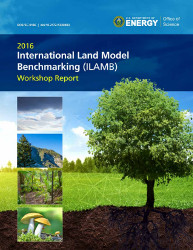| layout | title |
|---|---|
default |
ILAMB |
The International Land Model Benchmarking (ILAMB) project is a model-data intercomparison and integration project designed to improve the performance of land models and, in parallel, improve the design of new measurement campaigns to reduce uncertainties associated with key land surface processes. Building upon past model evaluation studies, described below, the goals of ILAMB are to:
-
develop internationally accepted benchmarks for land model performance,
-
promote the use of these benchmarks by the international community for model intercomparison,
-
strengthen linkages between experimental, remote sensing, and climate modeling communities in the design of new model tests and new measurement programs, and
-
support the design and development of a new, open source, benchmarking software system for use by the international community.
 |
Improving the representation of the carbon cycle and land surface processes in climate models requires extensive comparison of model results with observations. This process is difficult and time intensive. Past data-model intercomparisons have strengthened the representation of key processes in land models, but often this information has not been easily accessible for use by other modeling teams or in future intercomparisons. Specifically, there is a large cost in developing the infrastructure to make meaningful model-data comparisons, even when the data are freely and easily available. Further, the development of sophisticated model diagnostics programs—that can fully exploit the richness of large Earth System data sets like satellite or Fluxnet measurements—are outside the scope of any single modeling center. Thus, an important direction for the field is the development of a community-based model evaluation system that is open source and modular, allowing for contributions by many different modeling and measurement teams.
Multiple past intercomparison efforts provide a foundation a new international benchmarking activity. C4MIP provided the community with an elegant conceptual framework for diagnosing the causes of model-to-model differences in feedback strength (Friedlingstein et al., 2006; Gregory et al., 2009). The Carbon-Land Model Intercomparison Project (C-LAMP) also was a first step in this direction (Hoffman et al., 2008; Randerson et al., 2009). Nine different classes of observations were used to evaluate two biogeochemistry models (CASA′ and CN) within the Community Climate System Model. For each class of observations, the models received a score based on the quality of the fit with the measurements. Information from different data streams were weighted by the relative importance of the observational constraint, the uncertainty in the observations, and the uncertainty in the model. The code and model output from C-LAMP is publicly available and is now being used by several modeling centers in Europe and in the U.S.
Quick links: Repository, Installation, Tutorials, CMIP5 Results, CLM Results